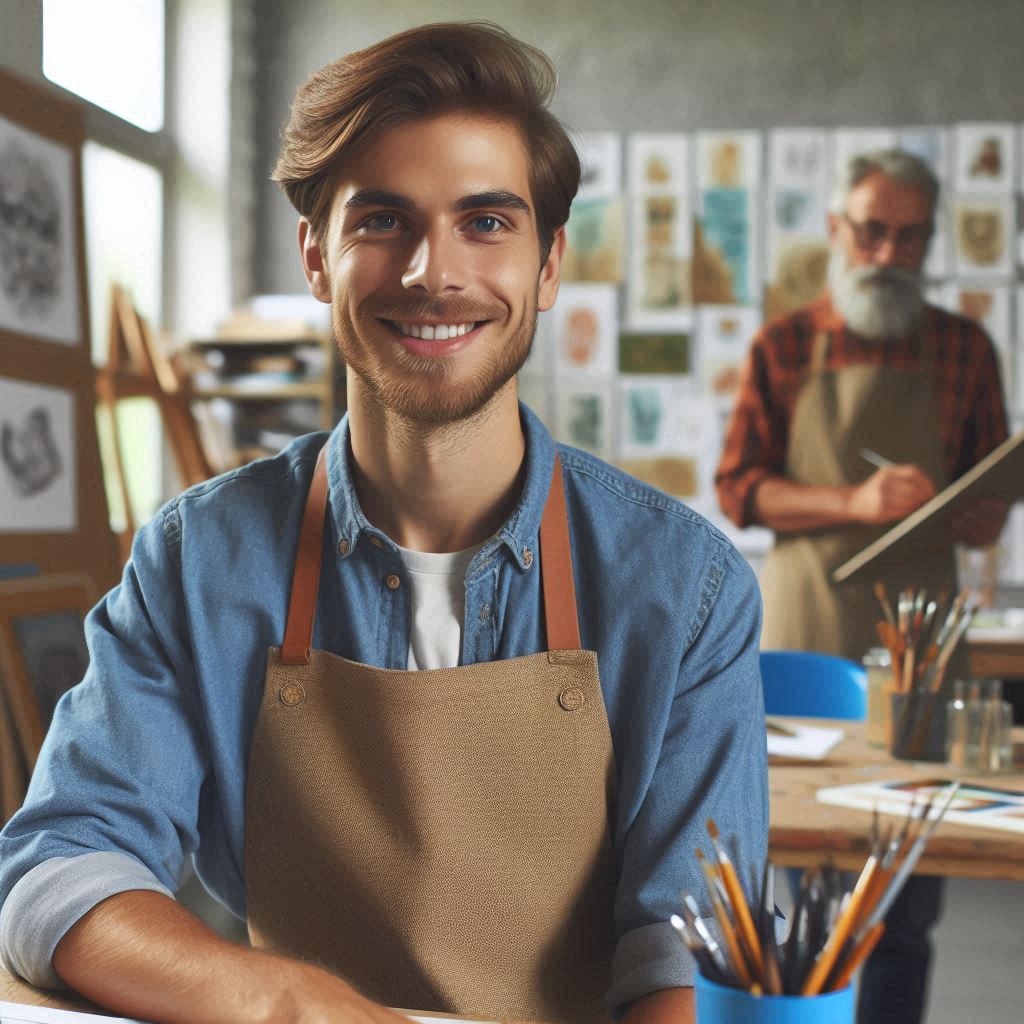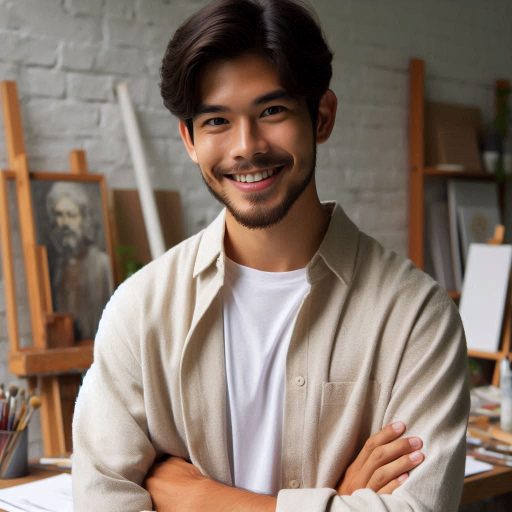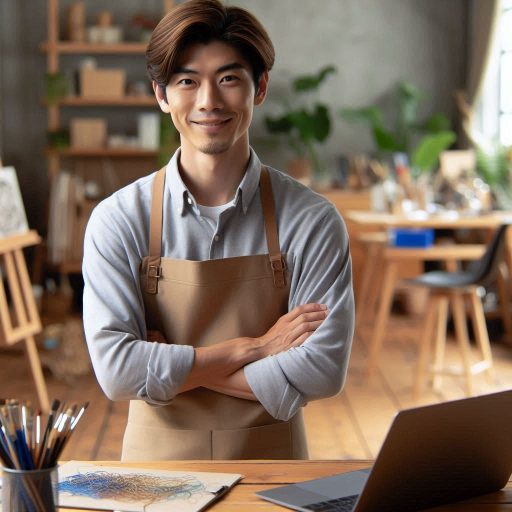Introduction
Innovative teaching strategies are crucial for art instructors.
They transform traditional methods, making learning dynamic and impactful.
Art education thrives on creativity, and fresh approaches keep students engaged.
Innovative strategies help instructors present material in new ways, fostering an inspiring environment.
Students benefit greatly from these modern techniques.
Traditional methods might not always capture their attention.
Innovative strategies introduce variety and excitement into lessons, making the learning process more enjoyable.
When students are engaged, their motivation to participate and excel increases.
Enhanced student engagement is one of the most significant advantages.
By incorporating novel teaching methods, art instructors can spark curiosity.
Interactive projects and multimedia tools make lessons more relatable and fun.
Students are more likely to be actively involved and invested in their work.
These strategies also improve learning outcomes.
When students are engaged, they absorb information more effectively.
They explore ideas more deeply and experiment with techniques.
This hands-on approach leads to a better understanding of artistic concepts and skills.
Furthermore, innovative strategies cater to different learning styles.
Visual learners might benefit from multimedia presentations, while hands-on learners thrive with interactive projects.
Tailoring lessons to diverse needs ensures all students can grasp the material.
In fact, innovative teaching strategies are essential for art instructors.
Transform Your Career Today
Unlock a personalized career strategy that drives real results. Get tailored advice and a roadmap designed just for you.
Start NowThey enhance student engagement and improve learning outcomes.
By embracing these approaches, art instructors create an environment that motivates and inspires students, leading to greater success in their artistic journey.
Incorporating Technology in the Classroom
The Use of Digital Tools and Software to Enhance Art Instruction
Digital tools and software revolutionize art instruction by offering innovative ways to teach and create.
Graphic design programs like Adobe Photoshop and Illustrator provide students with professional-grade tools for digital artwork.
Drawing tablets allow for precision and flexibility in creating digital pieces.
Interactive whiteboards and art apps foster engagement and enable real-time feedback.
These technologies enable students to experiment with different techniques and mediums, broadening their artistic skills and creativity.
How Virtual Reality and Augmented Reality Can Create Immersive Learning Experiences
Virtual Reality (VR) and Augmented Reality (AR) bring art instruction to life through immersive experiences.
VR allows students to explore virtual art galleries and historical art periods, providing context and inspiration.
AR apps overlay digital information onto physical artworks, offering interactive elements and deeper understanding.
These technologies create engaging learning environments where students can virtually interact with art pieces, enhancing their comprehension and appreciation.
They also enable students to visualize and manipulate their own creations in a virtual space, making learning both interactive and dynamic.
Examples of Online Platforms for Collaborative Art Projects
Online platforms facilitate collaborative art projects, connecting students with peers worldwide.
Websites like Google Classroom and Microsoft Teams offer tools for sharing and collaborating on art assignments.
Platforms such as Behance and DeviantArt allow artists to showcase their work and receive feedback from a global audience.
Online forums and social media groups provide spaces for discussion and collaboration on art projects.
These tools encourage students to work together, share ideas, and build a community around their artistic pursuits, enhancing their collaborative skills and broadening their artistic perspectives.
Incorporating technology in art education enriches the learning experience, making it more interactive and accessible.
By leveraging digital tools, VR/AR, and online platforms, art instructors can create innovative and engaging classroom environments that inspire creativity and collaboration.
Read: Important Costume Design Terminology
Transform Your Career Today
Unlock a personalized career strategy that drives real results. Get tailored advice and a roadmap designed just for you.
Start NowEncouraging creative thinking and problem-solving
Implementing open-ended assignments and projects to foster creativity
One way art instructors can encourage creative thinking and problem-solving in their students is by implementing open-ended assignments and projects.
These types of tasks allow students the freedom to explore their ideas and express themselves without strict limitations.
Open-ended assignments can range from creating a piece of artwork inspired by a certain theme to designing an exhibit layout for a gallery.
By giving students the opportunity to think outside the box, instructors can help them develop their unique artistic voice.
Promoting critical thinking skills through art analysis and interpretation
In addition to open-ended assignments, promoting critical thinking skills through art analysis and interpretation is another effective strategy.
Encouraging students to analyze and interpret different artworks helps them develop their ability to think critically about visual information.
Art analysis and interpretation can involve discussing the themes, styles, techniques, and historical context of various artworks.
By engaging students in these discussions, instructors can help them develop a deeper understanding and appreciation for art.
Encouraging students to experiment with different materials and techniques
Another way to encourage creative thinking is by encouraging students to experiment with different materials and techniques.
By exploring new mediums and approaches, students can expand their artistic vocabulary and develop their problem-solving skills.
Instructors can organize workshops or provide resources for students to experiment with a variety of materials, such as painting, sculpture, printmaking, or digital art.
This hands-on approach allows students to discover new possibilities and push the boundaries of their creativity.
By combining open-ended assignments, art analysis, and experimentation with different materials, art instructors can create a dynamic learning environment that fosters creativity and problem-solving skills in their students.
These innovative teaching strategies not only inspire students to think creatively but also equip them with the tools to tackle challenges in their artistic practice.
Read: Art and Design Teaching Certifications Explained
Experiential learning opportunities
Art instructors can enhance their teaching strategies by incorporating experiential learning opportunities into their curriculum.
These hands-on experiences provide students with practical skills and real-world application of art concepts.
Organizing field trips to museums, galleries, and art studios
Field trips are an excellent way to expose students to a wide range of artistic styles and techniques.
By visiting museums, galleries, and art studios, students can gain inspiration and insights from professional artists.
Art instructors can coordinate field trips to local museums to study famous artworks up close and engage in discussions about artistic techniques.
Transform Your Career Today
Unlock a personalized career strategy that drives real results. Get tailored advice and a roadmap designed just for you.
Start NowVisiting galleries allows students to explore contemporary art trends and interact with working artists.
Furthermore, organizing trips to art studios gives students the opportunity to observe artists at work and learn about their creative processes.
These experiences help students connect theoretical knowledge with practical application in a real-world setting.
Hosting guest artists for workshops and demonstrations
Inviting guest artists to conduct workshops and demonstrations can provide students with valuable insights and hands-on learning experiences.
Guest artists bring industry expertise and fresh perspectives to the classroom, enriching students’ understanding of art concepts.
Guest artists can lead hands-on workshops where students can learn new techniques and experiment with different mediums.
Demonstrations by professionals allow students to observe the creative process in action and ask questions about the artistic decision-making process.
Additionally, guest artists can share their personal experiences and career journeys, inspiring students to pursue their artistic aspirations.
These interactions foster mentorship relationships and open doors for networking opportunities in the art community.
Creating opportunities for students to showcase their work in community events and exhibitions
Encouraging students to participate in community events and exhibitions can boost their confidence and visibility as emerging artists.
Art instructors can help students prepare their portfolios and artwork for public display, showcasing their talents to a wider audience.
Students can exhibit their work at local art fairs, community centers, and galleries, gaining recognition and feedback from art enthusiasts and industry professionals.
Participating in exhibitions also helps students build their professional reputation and create networking opportunities with potential collaborators and clients.
Moreover, showcasing artwork in public settings allows students to receive valuable critique and feedback from a diverse range of viewers.
This feedback helps students refine their artistic skills, experiment with new ideas, and improve their creative expression over time.
In essence, providing experiential learning opportunities for art students is essential for fostering creativity, developing practical skills, and nurturing their passion for art.
By organizing field trips, hosting guest artists, and creating opportunities for public exhibitions, art instructors can empower students to enhance their artistic abilities and pursue a successful career in the arts.
Read: How Costume Designers Use Color Theory

Personalized Feedback and Assessment
Providing personalized feedback and assessment is crucial in art education.
It helps students grow and refine their skills effectively.
Transform Your Career Today
Unlock a personalized career strategy that drives real results. Get tailored advice and a roadmap designed just for you.
Start NowHere‘s how art instructors can enhance their feedback methods:
Using Rubrics and Peer Evaluations to Provide Constructive Criticism
Rubrics offer clear criteria for assessing student work.
They outline expectations and provide a structured way to evaluate performance.
Peer evaluations encourage students to analyze and critique each other‘s work.
This process fosters a deeper understanding of artistic standards and techniques.
Constructive criticism from peers also builds a collaborative learning environment.
Both rubrics and peer reviews guide students toward specific areas for improvement and offer diverse perspectives.
Offering Individualized Feedback to Help Students Improve Their Skills
Individualized feedback addresses each student‘s unique strengths and weaknesses.
Personalized comments focus on specific elements of their artwork, such as technique, creativity, and composition.
This targeted feedback helps students understand their progress and areas needing improvement.
Art instructors can schedule one-on-one meetings to discuss feedback in detail, offering practical advice and encouragement.
Such personalized attention motivates students and supports their artistic development.
Implementing Self-Assessment Tools for Students to Reflect on Their Own Progress
Self-assessment tools empower students to evaluate their own work.
Tools such as reflective journals or checklists guide them in assessing their artistic process and outcomes.
By reflecting on their own progress, students develop critical thinking and self-awareness.
This practice also encourages them to set personal goals and track their growth over time.
Self-assessment fosters independence and responsibility in learning, enhancing overall skill development.
Incorporating these strategies into art instruction ensures that feedback is both constructive and personalized.
Art instructors can support students in their creative journeys, helping them to advance their skills and achieve their artistic goals.
Read: Networking Tips for Art and Design Instructors
Transform Your Career Today
Unlock a personalized career strategy that drives real results. Get tailored advice and a roadmap designed just for you.
Start NowExplore Further: The Role of Technology in Exhibition Design
Delve into the Subject: Famous American Furniture Designers to Know
Cultivating a Supportive and Inclusive Classroom Environment
Creating a supportive and inclusive classroom environment is crucial for art instructors.
This approach fosters creativity and enhances student engagement.
Here‘s how to cultivate such an environment effectively:
Promoting Collaboration and Teamwork Among Students
Encourage students to work together on projects and assignments.
Group activities, like collaborative murals or group critiques, can enhance their teamwork skills.
Organize art challenges that require students to brainstorm and create collectively.
This method not only builds social skills but also encourages diverse perspectives in their work.
Promote an atmosphere where students feel comfortable sharing ideas and giving constructive feedback to one another.
Celebrating group achievements can further strengthen their collaborative spirit.
Emphasizing Diversity and Inclusion in Art Curriculum
Incorporate a wide range of artistic styles, cultures, and histories into your curriculum.
Highlight works from diverse artists and artistic traditions.
Encourage students to explore and discuss how different cultures express themselves through art.
Use lessons to address topics such as cultural heritage and representation.
This approach not only broadens students’ artistic understanding but also fosters respect and appreciation for different backgrounds.
Tailor projects to allow students to incorporate their own cultural influences and personal experiences.
Creating a Safe Space for Students to Express Themselves Without Judgment
Establish a classroom culture where every student’s voice is valued.
Encourage open discussions about their artwork and artistic choices.
Ensure that feedback is constructive and focused on the work, not the individual.
Transform Your Career Today
Unlock a personalized career strategy that drives real results. Get tailored advice and a roadmap designed just for you.
Start NowSet clear guidelines for respectful communication to prevent negative criticism.
Provide opportunities for students to showcase their art in a supportive setting.
This atmosphere helps students build confidence and express their unique perspectives freely.
It also promotes emotional well-being and encourages continuous creative exploration.
In summary, by fostering collaboration, emphasizing diversity, and ensuring a judgment-free space, art instructors can create an enriching environment that nurtures all students’ artistic development.
Professional development for art instructors
Attending workshops and conferences to stay updated on the latest teaching techniques
Attending workshops and conferences is crucial for art instructors to stay updated on the latest teaching techniques.
These events provide valuable insights and opportunities to learn from industry experts and fellow educators.
By attending workshops and conferences, art instructors can gain new perspectives, discover innovative teaching strategies, and stay current on trends in art education.
Participating in online courses to enhance teaching skills
Participating in online courses is another effective way for art instructors to enhance their teaching skills.
Online courses offer flexibility and convenience, allowing instructors to learn at their own pace and from the comfort of their own home.
These courses cover a wide range of topics, from art theory to practical teaching methods, providing instructors with the knowledge and tools they need to excel in their role.
Collaborating with colleagues to share best practices and innovative ideas
Collaborating with colleagues is essential for art instructors to share best practices and innovative ideas.
By working together with other educators, instructors can exchange experiences, discuss challenges, and brainstorm creative solutions.
Collaborating with colleagues also fosters a sense of community and camaraderie, creating a supportive environment where instructors can learn from each other and grow professionally.
Conclusion
In this blog post, we explored various innovative teaching strategies for art instructors.
We discussed techniques like incorporating technology, using collaborative projects, and integrating cross-disciplinary methods.
These approaches help make art education more engaging and effective.
Implementing innovative teaching strategies is crucial in art education.
These methods not only capture students’ attention but also enhance their creative skills.
By adopting new techniques, art instructors can create dynamic learning environments that foster artistic growth and exploration.
Transform Your Career Today
Unlock a personalized career strategy that drives real results. Get tailored advice and a roadmap designed just for you.
Start NowInnovative strategies keep the curriculum fresh and relevant, which is essential for maintaining student interest and involvement.
Art instructors should feel encouraged to experiment with new approaches and techniques.
Embracing innovation can lead to exciting discoveries and improved teaching outcomes.
Try integrating digital tools, collaborating with other disciplines, or exploring new artistic mediums.
Such experimentation can benefit students by providing diverse learning experiences and expanding their creative horizons.
In the end, innovative teaching strategies are vital for advancing art education.
They bring new energy to the classroom and support students’ artistic development.
Art instructors should continually seek out and apply fresh methods to enhance their teaching practices.
By doing so, they will inspire their students and contribute to a more vibrant and effective art education experience.
[E-Books for Sale]
The Big Book of 500 High-Paying Jobs in America: Unlock Your Earning Potential
$19.99 • 500 High-Paying Jobs • 330 pages
Explore 500 high-paying jobs in America and learn how to boost your career, earn more, and achieve success!
See All 500 High-Paying Jobs of this E-Book
1001 Professions Without a Degree: High-Paying American Jobs You Can Start Now
$19.99 • 1001 Professions Without a Degree • 174 pages
Discover 1001 high-paying jobs without a degree! Unlock career tips, skills, and success strategies for just $19.99!




